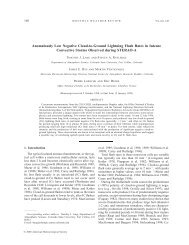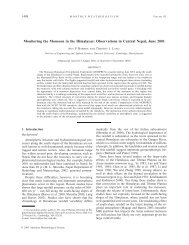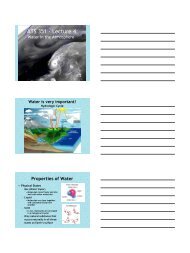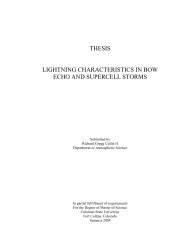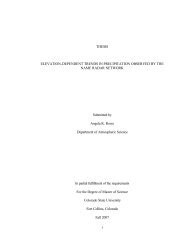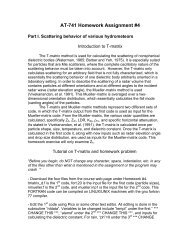1 A dual-polarization radar hydrometeor classification algorithm for ...
1 A dual-polarization radar hydrometeor classification algorithm for ...
1 A dual-polarization radar hydrometeor classification algorithm for ...
You also want an ePaper? Increase the reach of your titles
YUMPU automatically turns print PDFs into web optimized ePapers that Google loves.
126127128129130131132133134135136137138139140141142143144145146147<strong>algorithm</strong> definitions and equations). The T-matrix model computes the <strong>radar</strong> backscatteringcross section of particular <strong>hydrometeor</strong>s and the Mueller-matrix calculates polarimetric <strong>radar</strong>observations <strong>for</strong> a homogeneous, parameterized population of a given <strong>hydrometeor</strong> type. Theseresults are sensitive to the input parameters in Table 1, which we elaborate on in the remainder ofthis section.All <strong>hydrometeor</strong>s are modeled as oblate spheroids without branched or otherwiseirregular shapes, which is sufficient <strong>for</strong> X-, C-, and S-band weather <strong>radar</strong> applications (Bringiand Chandrasekar 2001). While scattering simulations are sensitive to phase (ice vs. liquid), theresults were negligibly sensitive to changes in temperature. 30° and 1° elevation angles weresimulated to determine how the <strong>radar</strong> would perceive high- and low-altitude ice particles. Sleetand rain are only expected to exist below the melting level so are simply modeled at 1°.Hydrometeor bulk density (! bulk ) is defined as the particle’s mass per unit volume. Theaxis ratio is assumed to compare the minor (“a”, basal, a-axis growth face) and major (“b”,prism, c-axis face) dimensions of a particle (“a/b”), where values approach one <strong>for</strong> spheres. Theparticle size distribution (PSD) D MIN , D MAX , diameter interval ("D), and functional shape areparameterized, from which we calculate D 0 . To represent the natural variability of precipitationin turbulent background flow, all <strong>hydrometeor</strong>s are assumed to have a Gaussian distribution ofcanting angles about a mean (# m ) of zero (Beard and Jameson 1983, Hendry et al. 1976, Spek etal. 2008). The fall behavior of indivi<strong>dual</strong> particles may vary greatly, but in the interest ofdistinguishing bulk <strong>hydrometeor</strong> types we used standard deviation of the canting angle ($) valueswhich best characterized how each particle type might fall differently from another.b) Model parameterizations <strong>for</strong> various <strong>hydrometeor</strong>s7



